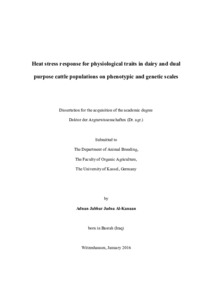| dc.date.accessioned | 2016-02-23T10:28:19Z | |
| dc.date.available | 2016-02-23T10:28:19Z | |
| dc.date.issued | 2016-02-23 | |
| dc.identifier.uri | urn:nbn:de:hebis:34-2016022349897 | |
| dc.identifier.uri | http://hdl.handle.net/123456789/2016022349897 | |
| dc.description.sponsorship | this work was supported by DAAD and Iraqi Ministery of Higher Education | eng |
| dc.language.iso | eng | |
| dc.rights | Urheberrechtlich geschützt | |
| dc.rights.uri | https://rightsstatements.org/page/InC/1.0/ | |
| dc.subject | Heat stress | eng |
| dc.subject | physiological traits | eng |
| dc.subject | semen traits | eng |
| dc.subject | genetic parameters | eng |
| dc.subject | dairy cattle | eng |
| dc.subject.ddc | 630 | |
| dc.title | Heat stress response for physiological traits in dairy and dual purpose cattle populations on phenotypic and genetic scales | eng |
| dc.type | Dissertation | |
| dcterms.abstract | The main objective of this thesis was to determine the potential impact of heat stress (HS) on physiological traits of lactating cows and semen quality of bulls kept in a temperate climate. The thesis is comprised of three studies. An innovative statistical modeling aspect common to all three studies was the application of random regression methodology (RRM) to study the phenotypic and genetic trajectory of traits in dependency of a continuous temperature humidity index (THI).
In the first study, semen quality and quantity traits of 562 Holstein sires kept on an AI station in northwestern Germany were analyzed in the course of THI calculated from data obtained from the nearest weather station. Heat stress was identified based on a decline in semen quality and quantity parameters. The identified general HS threshold (THI = 60) and the thermoneutal zone (THI in the range from 50 to 60) for semen production were lower than detected in studies conducted in tropical and subtropical climates. Even though adult bulls were characterized by higher semen productivity compared to younger bulls, they responded with a stronger semen production loss during harsh environments. Heritabilities (low to moderate range) and additive genetic variances of semen characteristics varied with different levels of THI. Also, based on genetic correlations genotype, by environment interactions were detected. Taken together, these findings suggest the application of specific selection strategies for specific climate conditions.
In the second study, the effect of the continuous environmental descriptor THI as measured inside the barns on rectal temperatures (RT), skin temperatures (ST), vaginal temperatures (VT), respiration rates (RR), and pulse rate (PR) of lactating Holstein Friesian (HF) and dual-purpose German black pied cattle (DSN) was analyzed. Increasing HS from THI 65 (threshold) to THI 86 (maximal THI) resulted in an increase of RT by 0.6 °C (DSN) and 1 °C (HF), ST by 3.5 °C (HF) and 8 °C (DSN), VT by 0.3 °C (DSN), and RR by 47 breaths / minute (DSN), and decreased PR by 7 beats / minute (DSN). The undesired effects of rising THI on physiological traits were most pronounced for cows with high levels of milk yield and milk constituents, cows in early days in milk and later parities, and during summer seasons in the year 2014.
In the third study of this dissertation, the genetic components of the cow’s physiological responses to HS were investigated. Heat stress was deduced from indoor THI measurements, and physiological traits were recorded on native DSN cows and their genetically upgraded crosses with Holstein Friesian sires in two experimental herds from pasture-based production systems reflecting a harsh environment of the northern part of Germany. Although heritabilities were in a low range (from 0.018 to 0.072), alterations of heritabilities, repeatabilities, and genetic components in the course of THI justify the implementation of genetic evaluations including heat stress components. However, low repeatabilities indicate the necessity of using repeated records for measuring physiological traits in German cattle. Moderate EBV correlations between different trait combinations indicate the potential of selection for one trait to simultaneously improve the other physiological attributes.
In conclusion, bulls of AI centers and lactating cows suffer from HS during more extreme weather conditions also in the temperate climate of Northern Germany. Monitoring physiological traits during warm and humid conditions could provide precious information for detection of appropriate times for implementation of cooling systems and changes in feeding and management strategies. Subsequently, the inclusion of these physiological traits with THI specific breeding values into overall breeding goals could contribute to improving cattle adaptability by selecting the optimal animal for extreme hot and humid conditions. Furthermore, the recording of meteorological data in close distance to the cow and visualizing the surface body temperature by infrared thermography techniques might be helpful for recognizing heat tolerance and adaptability in cattle. | eng |
| dcterms.accessRights | open access | |
| dcterms.creator | Al-Kanaan, Adnan Jabbar Jadoa | |
| dc.contributor.corporatename | Kassel, Universität Kassel, Fachbereich Ökologische Agrarwissenschaften | |
| dc.contributor.referee | König, Sven (Prof. Dr.) | |
| dc.contributor.referee | Gauly, Matthias (Prof. Dr. Dr.) | |
| dc.subject.swd | Hitzestress | ger |
| dc.subject.swd | Milchkuh | ger |
| dc.subject.swd | Bulle | ger |
| dc.date.examination | 2016-02-10 | |

